Quantitative Impacts of Climate Change and Human Activities on Grassland Productivity in Otog Banner, China from 2001 to 2020
Abstract
:1. Introduction
2. Materials and Methods
2.1. Study Area
2.2. Data Collection and Pre-Processing
2.3. Methods
2.3.1. Calculation of Grassland NPP
2.3.2. Changing Trend of Grassland NPP
2.3.3. Spatial Responses and Sensitivities of Grassland NPP to Climate Factors
2.3.4. Quantitative Evaluation of the Driving Factors to Grassland NPP Dynamics
3. Results
3.1. Interannual Variation in Grassland NPP
3.2. Spatial Patterns of Grassland NPP
3.3. Spatiotemporal Dynamics of Grassland NPP
3.4. Contributions of Climatic and Human Factors to Grassland NPP Dynamics
4. Discussion
4.1. Dynamics of Grassland NPP
4.2. Impacts of Climate Change and Human Activities on Grassland NPP
5. Conclusions and Perspectives
- (1)
- For the whole study area, grassland NPP showed a significant decrease trend with years. The multi-year mean value of grassland NPP was 175.17 g C m−2 yr−1, only half of that in Inner Mongolia. The spatial patterns of grassland NPP showed a strong linear correlation with the gradients of climate factors. Sunshine duration (SSD) was the most sensitive climate factor that affected the spatial patterns of grassland NPP in the study area.
- (2)
- 86.83% of the grassland area showed a degradation trend, including 39.71% seriously degraded and 47.12% slightly degraded. The negative contribution of HA to grassland NPP dynamics was −2.733 g C m−2 yr−1, while the positive contribution of CC was only 0.593 g C m−2 yr−1. The climate-dominated degradation was mainly distributed in the west, while the human-dominated degradation was mainly distributed in the middle and east.
- (3)
- The overall degradation of the grassland in Otog Banner was the joint result of CC and HA. The climate-dominated degradation was mainly distributed in the west and accounted for 29.97% of the total grassland area; while the human-dominated degradation was mainly distributed in the middle and east and accounted for 56.86% of the total grassland area.
- (4)
- The study results showed that the stability of the grassland ecosystem in Otog Banner has been seriously threatened. The government should further strengthen the protection measures for the grassland ecosystem in order to curb the damage of HA and mitigate the adverse effects of CC on the grassland ecosystem. Additionally, actively developing the artificial grassland and yard-feeding livestock industry, a development model of animal husbandry that combines planting and breeding, could fully utilize the advantages of local natural resources, and enhance the carrying capacity and anti-interference ability of grassland resources in Otog Banner. At the same time, encouraging agricultural and pastoral families to develop diversified production and operation models, expanding their income sources through working outside, would gradually weaken their dependence on natural resources for survival and livelihood, achieving sustainable development of the social economy and ecosystem in pastoral area.
- (5)
- In the study, we quantified and separated the impact of CC and HA on grassland NPP, and quantitatively analyzed the driving contributions of different climate factors to grassland NPP dynamics. The study results can provide reference for the sustainable utilization and management of grassland ecosystems in Otog Banner, and provide an approach for quantitatively analyzing the responses of grassland or other vegetation ecosystems to climate change and human activities at different spatiotemporal scales. However, the study did not achieve a separate assessment of the impact of different HA types. This requires extensive investigation work as the basis, and further related work will be carried out in future research. In addition, grassland NPP is an important indicator in the carbon cycle process. Under the background of “Carbon Peaking and Carbon Neutrality” in China, research on the carbon sequestration effect of grassland ecosystems is also the focus of future work.
Author Contributions
Funding
Data Availability Statement
Conflicts of Interest
References
- Field, C.B.; Behrenfeld, M.J.; Randerson, J.T.; Falkowski, P. Primary Production of the Biosphere: Integrating Terrestrial and Oceanic Components. Science 1998, 281, 237–240. [Google Scholar] [CrossRef] [PubMed]
- Steffen, W.; Noble, I.; Canadell, J.; Apps, M.; Schulze, E.-D.; Jarvis, P.G. The Terrestrial Carbon Cycle: Implications for the Kyoto Protocol. Science 1998, 280, 1393–1394. [Google Scholar] [CrossRef]
- Dong, J.; Kaufmann, R.K.; Myneni, R.B.; Tucker, C.J.; Kauppi, P.E.; Liski, J.; Buermann, W.; Alexeyev, V.; Hughes, M.K. Remote Sensing Estimates of Boreal and Temperate Forest Woody Biomass: Carbon Pools, Sources, and Sinks. Remote Sens. Environ. 2003, 84, 393–410. [Google Scholar] [CrossRef]
- Chen, L.; Li, H.; Zhang, P.; Zhao, X.; Zhou, L.; Liu, T.; Hu, H.; Bai, Y.; Shen, H.; Fang, J. Climate and Native Grassland Vegetation as Drivers of the Community Structures of Shrub-Encroached Grasslands in Inner Mongolia, China. Landsc. Ecol. 2015, 30, 1627–1641. [Google Scholar] [CrossRef]
- Haberl, H.; Erb, K.H.; Krausmann, F.; Gaube, V.; Bondeau, A.; Plutzar, C.; Gingrich, S.; Lucht, W.; Fischer-Kowalski, M. Quantifying and Mapping the Human Appropriation of Net Primary Production in Earth’s Terrestrial Ecosystems. Proc. Natl. Acad. Sci. USA 2007, 104, 12942–12947. [Google Scholar] [CrossRef]
- Potter, C.S.; Randerson, J.T.; Field, C.B.; Matson, P.A.; Vitousek, P.M.; Mooney, H.A.; Klooster, S.A. Terrestrial Ecosystem Production: Process Model Based on Global Satellite and Surface Data. Glob. Biogeochem. Cycles 1993, 7, 811–841. [Google Scholar] [CrossRef]
- Liu, Y.; Yang, Y.; Wang, Q.; Khalifa, M.; Zhang, Z.; Tong, L.; Li, J.; Shi, A. Assessing the Dynamics of Grassland Net Primary Productivity in Response to Climate Change at the Global Scale. Chin. Geogr. Sci. 2019, 29, 725–740. [Google Scholar] [CrossRef]
- Wei, X.; Yan, C.; Wei, W. Grassland Dynamics and the Driving Factors Based on Net Primary Productivity in Qinghai Province, China. ISPRS Int. J. Geo-Inf. 2019, 8, 73. [Google Scholar] [CrossRef]
- Schaefer, K.; Collatz, G.J.; Tans, P.; Denning, A.S.; Baker, I.; Berry, J.; Prihodko, L.; Suits, N.; Philpott, A. Combined Simple Biosphere/Carnegie-Ames-Stanford Approach Terrestrial Carbon Cycle Model. J. Geophys. Res. Biogeosci. 2008, 113, 1–13. [Google Scholar] [CrossRef]
- Zhang, J.; Hao, X.; Hao, H.; Fan, X.; Li, Y. Climate Change Decreased Net Ecosystem Productivity in the Arid Region of Central Asia. Remote Sens. 2021, 13, 4449. [Google Scholar] [CrossRef]
- Pu, S.; Fang, J.; He, J.; Xiao, Y. Spatial distribution of grassland biomass in China. Acta Phytoecol. Sin. 2014, 28, 491–498. (In Chinese) [Google Scholar]
- Zhu, W.; Pan, Y.; He, H.; Yu, D.; Hu, H. Simulation of Maximum Light Use Efficiency for Some Typical Vegetation Types in China. Chin. Sci. Bull. 2006, 51, 457–463. [Google Scholar] [CrossRef]
- Fang, J.Y.; Guo, Z.; Di Piao, S.L.; Chen, A.P. Terrestrial Vegetation Carbon Sinks in China, 1981–2000. Sci. China Ser. D Earth Sci. 2007, 50, 1341–1350. [Google Scholar] [CrossRef]
- Bengtsson, J.; Bullock, J.M.; Egoh, B.; Everson, C.; Everson, T.; O’Connor, T.; O’Farrell, P.J.; Smith, H.G.; Lindborg, R. Grasslands-More Important for Ecosystem Services than You Might Think. Ecosphere 2019, 10, e02582. [Google Scholar] [CrossRef]
- Liu, Y.; Yang, Y.; Wang, Q.; Du, X.; Li, J.; Gang, C.; Zhou, W.; Wang, Z. Evaluating the Responses of Net Primary Productivity and Carbon Use Efficiency of Global Grassland to Climate Variability along an Aridity Gradient. Sci. Total Environ. 2019, 652, 671–682. [Google Scholar] [CrossRef]
- Chen, T.; Bao, A.; Jiapaer, G.; Guo, H.; Zheng, G.; Jiang, L.; Chang, C.; Tuerhanjiang, L. Disentangling the Relative Impacts of Climate Change and Human Activities on Arid and Semiarid Grasslands in Central Asia during 1982–2015. Sci. Total Environ. 2019, 653, 1311–1325. [Google Scholar] [CrossRef]
- Yang, Y.; Wang, Z.; Li, J.; Gang, C.; Zhang, Y.; Zhang, Y.; Odeh, I.; Qi, J. Comparative Assessment of Grassland Degradation Dynamics in Response to Climate Variation and Human Activities in China, Mongolia, Pakistan and Uzbekistan from 2000 to 2013. J. Arid Environ. 2016, 135, 164–172. [Google Scholar] [CrossRef]
- Liu, Y.; Wang, Q.; Zhang, Z.; Tong, L.; Wang, Z.; Li, J. Grassland Dynamics in Responses to Climate Variation and Human Activities in China from 2000 to 2013. Sci. Total Environ. 2019, 690, 27–39. [Google Scholar] [CrossRef]
- Zhou, W.; Yang, H.; Huang, L.; Chen, C.; Lin, X.; Hu, Z.; Li, J. Grassland Degradation Remote Sensing Monitoring and Driving Factors Quantitative Assessment in China from 1982 to 2010. Ecol. Indic. 2017, 83, 303–313. [Google Scholar] [CrossRef]
- Liu, Y.; Zhou, R.; Ren, H.; Zhang, W.; Zhang, Z.; Zhang, Z.; Wen, Z. Evaluating the Dynamics of Grassland Net Primary Productivity in Response to Climate Change in China. Glob. Ecol. Conserv. 2021, 28, e01574. [Google Scholar] [CrossRef]
- Yan, Y.; Liu, X.; Wen, Y.; Ou, J. Quantitative Analysis of the Contributions of Climatic and Human Factors to Grassland Productivity in Northern China. Ecol. Indic. 2019, 103, 542–553. [Google Scholar] [CrossRef]
- Xu, H.; Wang, X.; Zhang, X. Alpine Grasslands Response to Climatic Factors and Anthropogenic Activities on the Tibetan Plateau from 2000 to 2012. Ecol. Eng. 2016, 92, 251–259. [Google Scholar] [CrossRef]
- Chen, T.; Tang, G.; Yuan, Y.; Guo, H.; Xu, Z.; Jiang, G.; Chen, X. Unraveling the Relative Impacts of Climate Change and Human Activities on Grassland Productivity in Central Asia over Last Three Decades. Sci. Total Environ. 2020, 743, 140649. [Google Scholar] [CrossRef] [PubMed]
- Guo, D.; Song, X.; Hu, R.; Cai, S.; Zhu, X.; Hao, Y. Grassland Type-Dependent Spatiotemporal Characteristics of Productivity in Inner Mongolia and Its Response to Climate Factors. Sci. Total Environ. 2021, 775, 145644. [Google Scholar] [CrossRef]
- Mu, S.; Zhou, S.; Chen, Y.; Li, J.; Ju, W.; Odeh, I.O.A. Assessing the Impact of Restoration-Induced Land Conversion and Management Alternatives on Net Primary Productivity in Inner Mongolian Grassland, China. Glob. Planet. Chang. 2013, 108, 29–41. [Google Scholar] [CrossRef]
- Liu, H.; Song, X.; Wen, W.; Jia, Q.; Zhu, D. Quantitative Effects of Climate Change on Vegetation Dynamics in Alpine Grassland of Qinghai-Tibet Plateau in a County. Atmosphere 2022, 13, 324. [Google Scholar] [CrossRef]
- Hu, Y.; Nacun, B. An Analysis of Land-Use Change and Grassland Degradation from a Policy Perspective in Inner Mongolia, China, 1990–2015. Sustainability 2018, 10, 4048. [Google Scholar] [CrossRef]
- Zhou, W.; Yang, H.; Zhou, L.; Chen, Y.; Huang, L.; Ju, W. Dynamics of Grassland Carbon Sequestration and Its Coupling Relation with Hydrothermal Factor of Inner Mongolia. Ecol. Indic. 2018, 95, 1–11. [Google Scholar] [CrossRef]
- Zhou, W.; Gang, C.; Zhou, L.; Chen, Y.; Li, J.; Ju, W.; Odeh, I. Dynamic of Grassland Vegetation Degradation and Its Quantitative Assessment in the Northwest China. Acta Oecologica 2014, 55, 86–96. [Google Scholar] [CrossRef]
- Zhao, Y.; Liu, H.; Zhang, A.; Cui, X.; Zhao, A. Spatiotemporal Variations and Its Influencing Factors of Grassland Net Primary Productivity in Inner Mongolia, China during the Period 2000–2014. J. Arid Environ. 2019, 165, 106–118. [Google Scholar] [CrossRef]
- Zhao, H.L.; Zhao, X.Y.; Zhou, R.L.; Zhang, T.H.; Drake, S. Desertification Processes Due to Heavy Grazing in Sandy Rangeland, Inner Mongolia. J. Arid Environ. 2005, 62, 309–319. [Google Scholar] [CrossRef]
- Zheng, Y.R.; Zhang, X.S. The diagnosis and optimal design of high efficient ecological economy system in maowusu sandy land. Acta Phytoecol. Sin. 1998, 22, 262–268. (In Chinese) [Google Scholar]
- Li, X.G.; Liu, H.M.; Wang, L.X.; Zhuo, Y. Vegetation cover change and its relationship between climate and human activities in ordos plateau. Chin. J. Agrometeorol. 2014, 35, 470–476. (In Chinese) [Google Scholar]
- Zhou, S.Q.; Zhao, K. Coupling coordination of capital and livelihood stability of farmers and herdsmen in the agro-pastoral ecotone in northern China. Arid Land Resour. Environ. 2022, 36, 9–15. (In Chinese) [Google Scholar]
- Zhou, L.H.; Hou, C.X. Key problems of grassland utilization and the graze ban policy in farming-pastoral ecotone of Northern China. Arid Land Geogr. 2019, 42, 354–362. (In Chinese) [Google Scholar]
- Allen, R.G.; Pereira, L.S.; Raes, D.; Smith, M. Crop Evapotranspiration: Guidelines for Computing Crop Water Requirements; FAO Irrigation and Drainage Paper No. 56, Rome; Food Agric. Organ: Roma, Italy, 1998. [Google Scholar]
- Field, C.B.; Randerson, J.T.; Malmström, C.M. Global Net Primary Production: Combining Ecology and Remote Sensing. Remote Sens. Environ. 1995, 51, 74–88. [Google Scholar] [CrossRef]
- Potter, C.S. Continental-Scale Comparisons of Terrestrial Carbon Sinks Estimated from Satellite Data and Ecosystem Modeling 1982–1998. Glob. Planet. Chang. 2003, 39, 201–213. [Google Scholar] [CrossRef]
- Yu, D.; Shi, P.; Shao, H.; Zhu, W.; Pan, Y. Modelling Net Primary Productivity of Terrestrial Ecosystems in East Asia Based on an Improved CASA Ecosystem Model. Int. J. Remote Sens. 2009, 30, 4851–4866. [Google Scholar] [CrossRef]
- Bao, G.; Xin, X.; Bao, Y.; Wang, M.; Yuan, Z.; Wulantuya. Optimization of maximum light use efficiency in Inner Mongolia Steppe. Spectrosc. Spectr. Anal. 2016, 36, 3280–3286. (In Chinese) [Google Scholar]
- Sellers, P.J. Canopy Reflectance, Photosynthesis and Transpiration. Int. J. Remote Sens. 1985, 6, 1335–1372. [Google Scholar] [CrossRef]
- Los, S.O.; Justice, C.O.; Tucker, C.J. A Global 1° by 1° NDVI Data Set for Climate Studies Derived from the GIMMS Continental NDVI Data. Int. J. Remote Sens. 1994, 15, 3493–3518. [Google Scholar] [CrossRef]
- Sellers, P.J.; Randall, D.A.; Collatz, G.J.; Berry, J.A.; Field, C.B.; Dazlich, D.A.; Zhang, C.; Collelo, G.D.; Bounoua, L. A Revised Land Surface Parameterization (SiB2) for Atmospheric GCMs. Part 1. Model Formulation. J. Clim. 1996, 9, 676–705. [Google Scholar] [CrossRef]
- Los, S.O. Linkages between Global Vegetation and Climate: An Analysis Based on NOAA Advanced Very High Resolution Radiometer Data; National Aeronautics and Space Administration (NASA): Washington, DC, USA, 1998. [Google Scholar]
- Li, K.; Liu, X.; Hu, Y.; Mohammat, A.; Geng, F.; Han, W. Long-Term Increasing Productivity of High-Elevation Grassland Caused by Elevated Precipitation and Temperature. Rangel. Ecol. Manag. 2020, 73, 156–161. [Google Scholar] [CrossRef]
- Li, D.; Xu, D.; Wang, Z.; You, X.; Zhang, X.; Song, A. The Dynamics of Sand-Stabilization Services in Inner Mongolia, China from 1981 to 2010 and Its Relationship with Climate Change and Human Activities. Ecol. Indic. 2018, 88, 351–360. [Google Scholar] [CrossRef]
- Beven, K. A Sensitivity Analysis of the Penman-Monteith Actual Evapotranspiration Estimates. J. Hydrol. 1979, 44, 169–190. [Google Scholar] [CrossRef]
- Yin, Y.; Wu, S.; Dai, E. Spatio-temporal attribution of potential evapotranspiration in China from 1971 to 2008. Chin. Sci. Bull. 2010, 55, 3329–3337. (In Chinese) [Google Scholar] [CrossRef]
- Guo, W.; Huang, S.; Zhao, J.; Li, Z.; Huang, Q.; Deng, M. Spatio-temporal dynamics and driving forces of potential evapotranspiration in the Wei River Basin. Trans. Chin. Soc. Agric. Eng. 2021, 37, 81–89. (In Chinese) [Google Scholar]
- Zhang, M.; Yuan, N.; Lin, H.; Liu, Y.; Zhang, H. Quantitative Estimation of the Factors Impacting Spatiotemporal Variation in NPP in the Dongting Lake Wetlands Using Landsat Time Series Data for the Last Two Decades. Ecol. Indic. 2022, 135, 108544. [Google Scholar] [CrossRef]
- Roderick, M.L.; Rotstayn, L.D.; Farquhar, G.D.; Hobbins, M.T. On the Attribution of Changing Pan Evaporation. Geophys. Res. Lett. 2007, 34, L17403. [Google Scholar] [CrossRef]
- Gao, Y.; Wang, H.; Zhao, M. Spatio-temporal dynamics of vegetation net primary productivity and its response to climate change in desert steppe, Inner Mongolia: A case study in Siziwang Banner. J. China Agric. Univ. 2020, 25, 100–107. (In Chinese) [Google Scholar]
- Yang, H.; Zhou, W.; Shi, P.; Huang, L. Analysis of temporal-spatial variations of NPP and coupling relationship with hydrothermal factors in grasslands of Inner Mongolia. Res. Soil Water Conserv. 2019, 26, 234–240. (In Chinese) [Google Scholar]
- Ren, H.; Shang, Y.; Zhang, S. Measuring the Spatiotemporal Variations of Vegetation Net Primary Productivity in Inner Mongolia Using Spatial Autocorrelation. Ecol. Indic. 2020, 112, 106108. [Google Scholar] [CrossRef]
- Hao, L.; Wang, S.; Cui, X.; Zhai, Y. Spatiotemporal Dynamics of Vegetation Net Primary Productivity and Its Response to Climate Change in Inner Mongolia from 2002 to 2019. Sustainability 2021, 13, 13310. [Google Scholar] [CrossRef]
- Zhang, T.; Yu, G.; Chen, Z.; Hu, Z.; Jiao, C.; Yang, M.; Fu, Z.; Zhang, W.; Han, L.; Fan, M.; et al. Patterns and Controls of Vegetation Productivity and Precipitation-Use Efficiency across Eurasian Grasslands. Sci. Total Environ. 2020, 741, 140204. [Google Scholar] [CrossRef] [PubMed]
- Qin, X.; Hong, J.; Ma, X.; Wang, X. Global Patterns in Above-Ground Net Primary Production and Precipitation-Use Efficiency in Grasslands. J. Mt. Sci. 2018, 15, 1682–1692. [Google Scholar] [CrossRef]
- Hossain, M.L.; Li, J. Effects of Long-Term Climatic Variability and Harvest Frequency on Grassland Productivity across Five Ecoregions. Glob. Ecol. Conserv. 2020, 23, e01154. [Google Scholar] [CrossRef]
- Jia, W.; Liu, M.; Yang, Y.; He, H.; Zhu, X.; Yang, F.; Yin, C.; Xiang, W. Estimation and Uncertainty Analyses of Grassland Biomass in Northern China: Comparison of Multiple Remote Sensing Data Sources and Modeling Approaches. Ecol. Indic. 2016, 60, 1031–1040. [Google Scholar] [CrossRef]
- Yue, S.; Xu, D.; Liu, C. Photosynthetic characteristics and main influence factors of five kinds of forage grass in desert steppe. Southwest China J. Agric. Sci. 2015, 28, 390–396. (In Chinese) [Google Scholar]
- Kasischke, E.S.; Melack, J.M.; Craig Dobson, M. The Use of Imaging Radars for Ecological Applications—A Review. Remote Sens. Environ. 1997, 59, 141–156. [Google Scholar] [CrossRef]
- Li, P.; Bennett, J. Understanding Herders’ Stocking Rate Decisions in Response to Policy Initiatives. Sci. Total Environ. 2019, 672, 141–149. [Google Scholar] [CrossRef]
- Su, R.; Yu, T.; Dayananda, B.; Bu, R.; Su, J.; Fan, Q. Impact of Climate Change on Primary Production of Inner Mongolian Grasslands. Glob. Ecol. Conserv. 2020, 22, e00928. [Google Scholar] [CrossRef]
- Hua, Y.; Sa, R.; Wang, B. Spatial and temporal variation of grassland NPP and its driving forces in Inner Mongolia. J. Desert Res. 2021, 41, 130–139. (In Chinese) [Google Scholar]
- Hao, L.; Sun, G.; Liu, Y.; Gao, Z.; He, J.; Shi, T.; Wu, B. Effects of Precipitation on Grassland Ecosystem Restoration under Grazing Exclusion in Inner Mongolia, China. Landsc. Ecol. 2014, 29, 1657–1673. [Google Scholar] [CrossRef]
- Hoffmann, C.; Giese, M.; Dickhoefer, U.; Wan, H.; Bai, Y.; Steffens, M.; Liu, C.; Butterbach-Bahl, K.; Han, X. Effects of Grazing and Climate Variability on Grassland Ecosystem Functions in Inner Mongolia: Synthesis of a 6-Year Grazing Experiment. J. Arid Environ. 2016, 135, 50–63. [Google Scholar] [CrossRef]
- Liu, H.; Song, X.; Qin, L.; Wen, W.; Liu, X.; Hu, Z.; Liu, Y. Improvement and Application of Key Pasture Theory for the Evaluation of Forage–Livestock Balance in the Seasonal Grazing Regions of China’s Alpine Desert Grasslands. Sustainability 2020, 12, 6794. [Google Scholar] [CrossRef]
- Li, H.; Hong, Y.; Deng, G.; Wu, R.; Zhang, H.; Zhao, J.; Guo, X. Impact of climate change and human activities on net primary productivity of grasslands in Inner Mongolia, China during 1982−2015. Chin. J. Appl. Ecol. 2021, 32, 415–424. (In Chinese) [Google Scholar]
- Zhang, M.; Lal, R.; Zhao, Y.; Jiang, W.; Chen, Q. Spatial and Temporal Variability in the Net Primary Production of Grassland in China and Its Relation to Climate Factors. Plant Ecol. 2017, 218, 1117–1133. [Google Scholar] [CrossRef]
- Ma, R.; Xia, C.; Liu, Y.; Wang, Y.; Zhang, J.; Shen, X.; Lu, X.; Jiang, M. Spatiotemporal Change of Net Primary Productivity and Its Response to Climate Change in Temperate Grasslands of China. Front. Plant Sci. 2022, 13, 899800. [Google Scholar] [CrossRef]
- Wu, N.; Liu, A.; Ye, R.; Yu, D.; Du, W.; Chaolumeng, Q.; Liu, G.; Yu, S. Quantitative Analysis of Relative Impacts of Climate Change and Human Activities on Xilingol Grassland in Recent 40 Years. Glob. Ecol. Conserv. 2021, 32, e01884. [Google Scholar] [CrossRef]
- Grime, J.P. Competitive Exclusion in Herbaceous Vegetation. Nature 1973, 242, 344–347. [Google Scholar] [CrossRef]
- Liu, Y.Y.; Zhang, Z.Y.; Tong, L.J.; Wang, Q.; Zhou, W.; Wang, Z.Q.; Li, J.L. Spatiotemporal dynamics of China’s grassland NPP and its driving factors. Chin. J. Ecol. 2020, 39, 349–363. (In Chinese) [Google Scholar]
- Robinson, B.E.; Li, P.; Hou, X. Institutional Change in Social-Ecological Systems: The Evolution of Grassland Management in Inner Mongolia. Glob. Environ. Chang. 2017, 47, 64–75. [Google Scholar] [CrossRef]
- Wang, M.N. Analysis on the Influence of the Second Round of Grassland Ecological Protection Subsidy and Reward Policy on Grassland Productivity and Social Development in Otog. Master Thesis, Inner Mongolia Agricultural University, Hohhot, China, 2021. [Google Scholar]

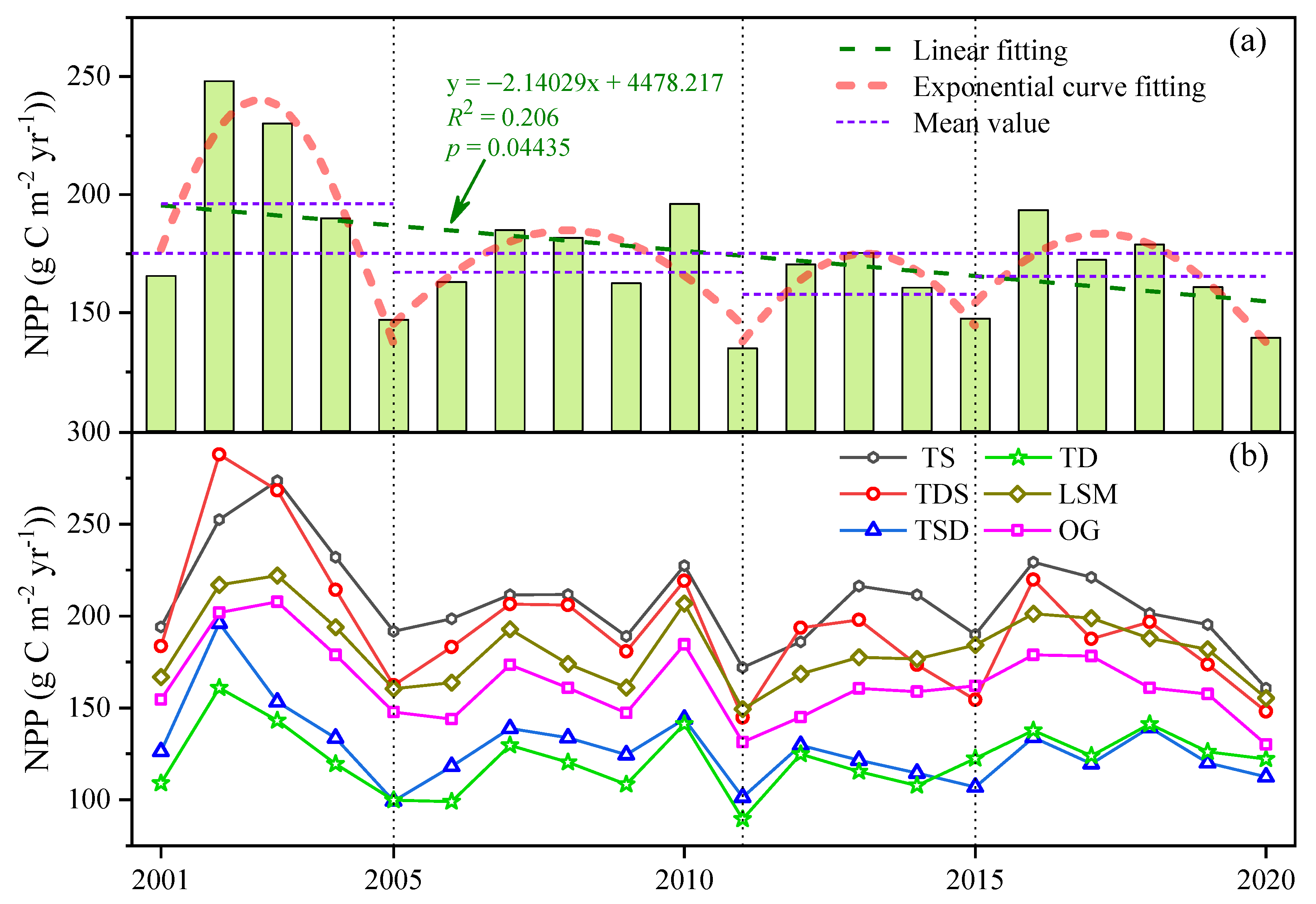
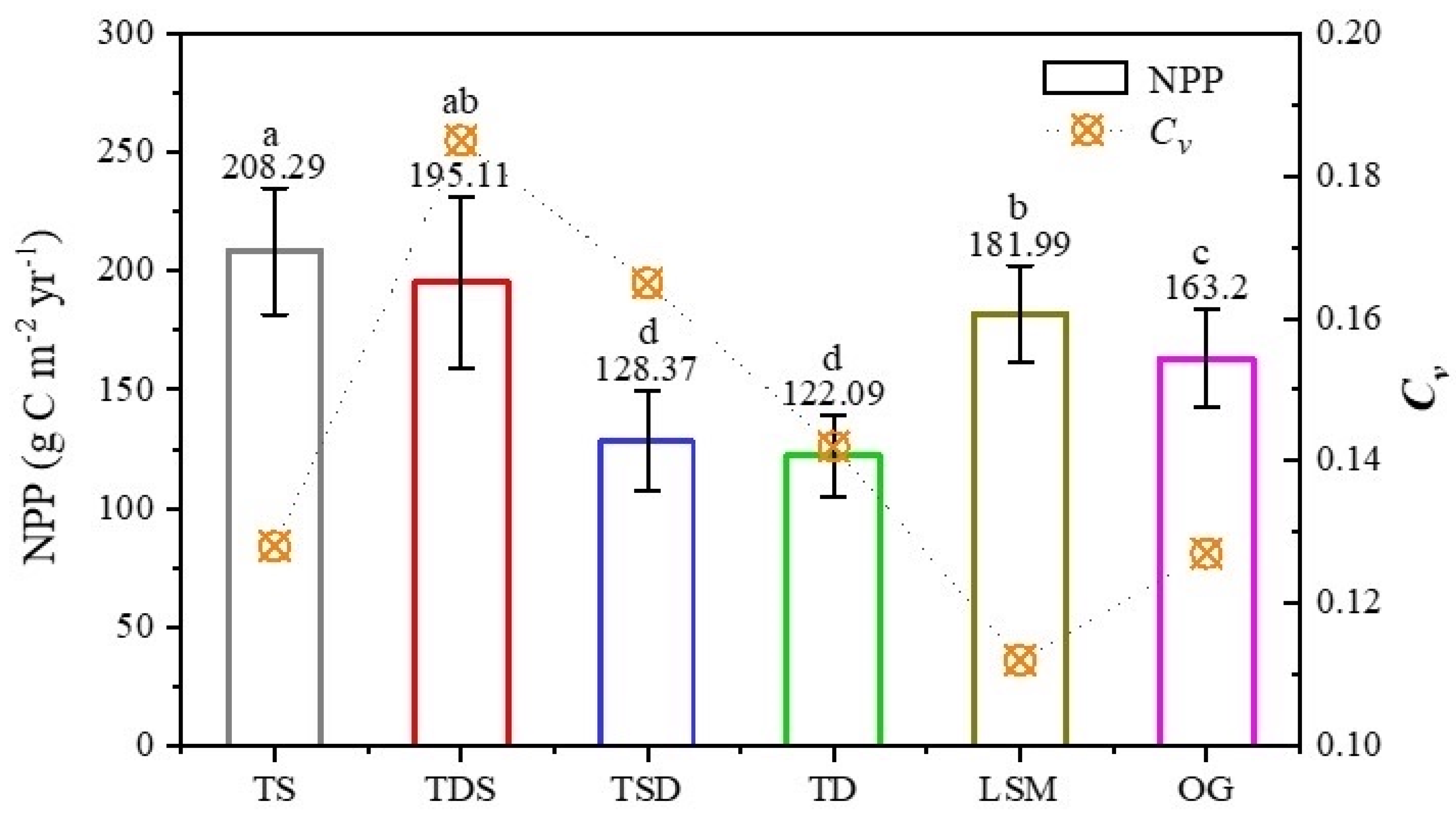
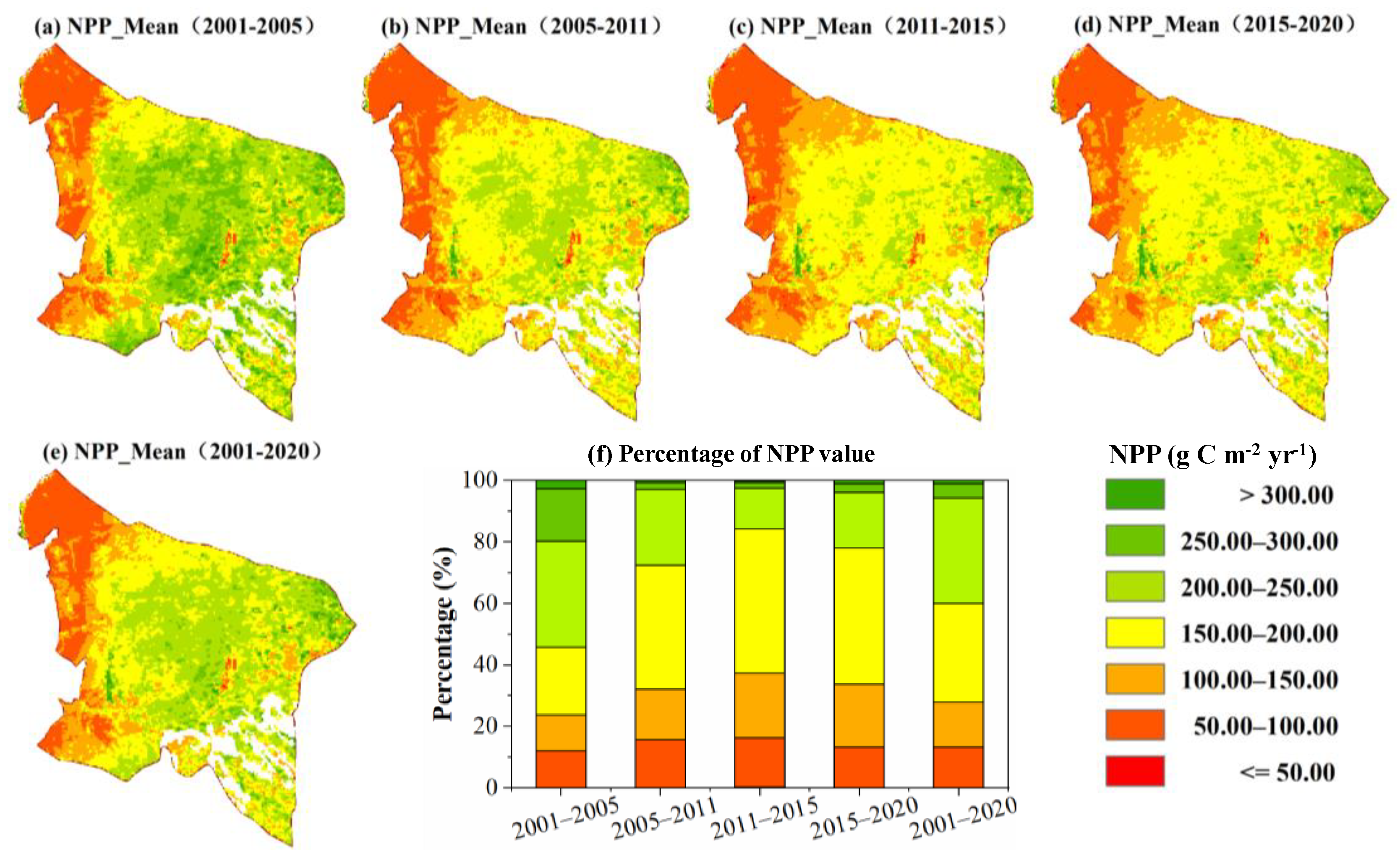

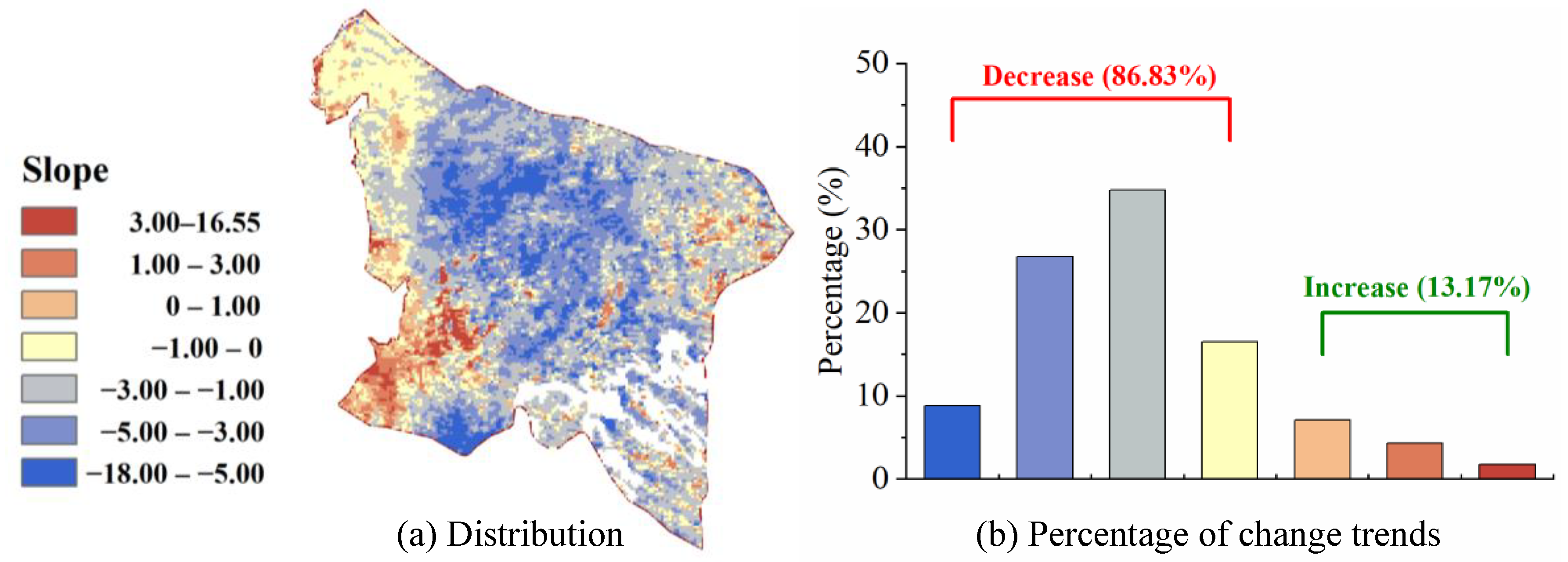
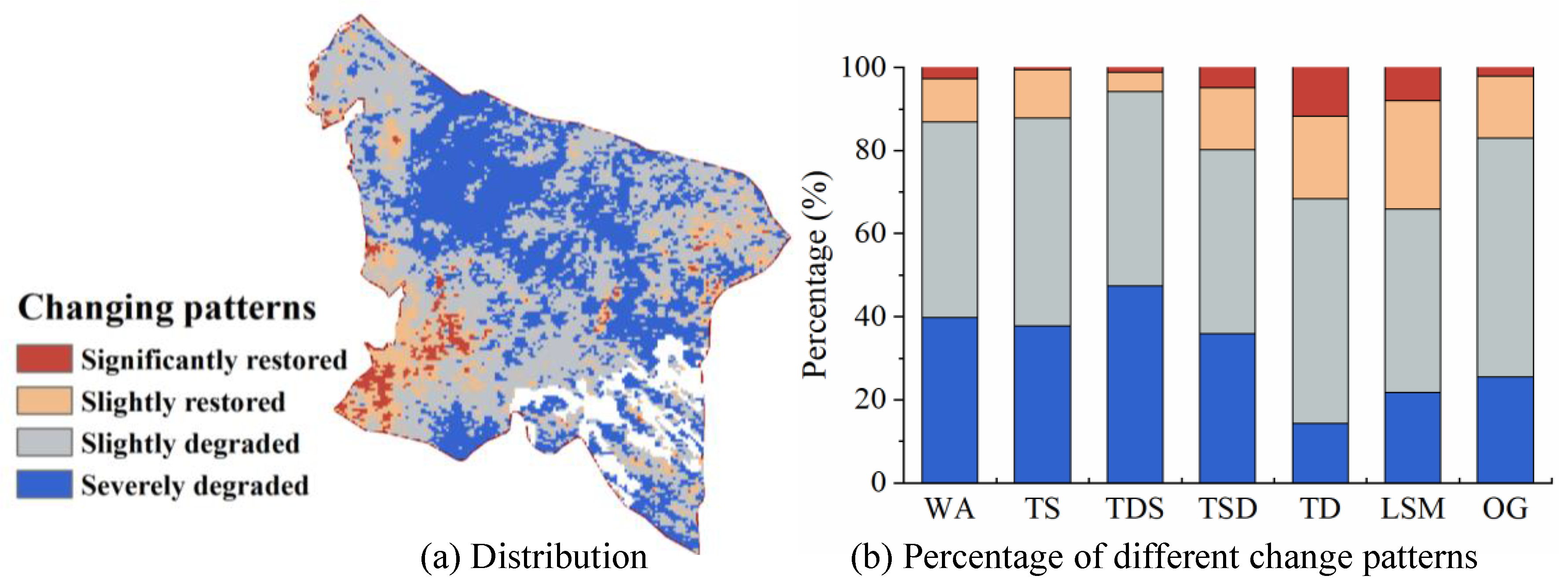
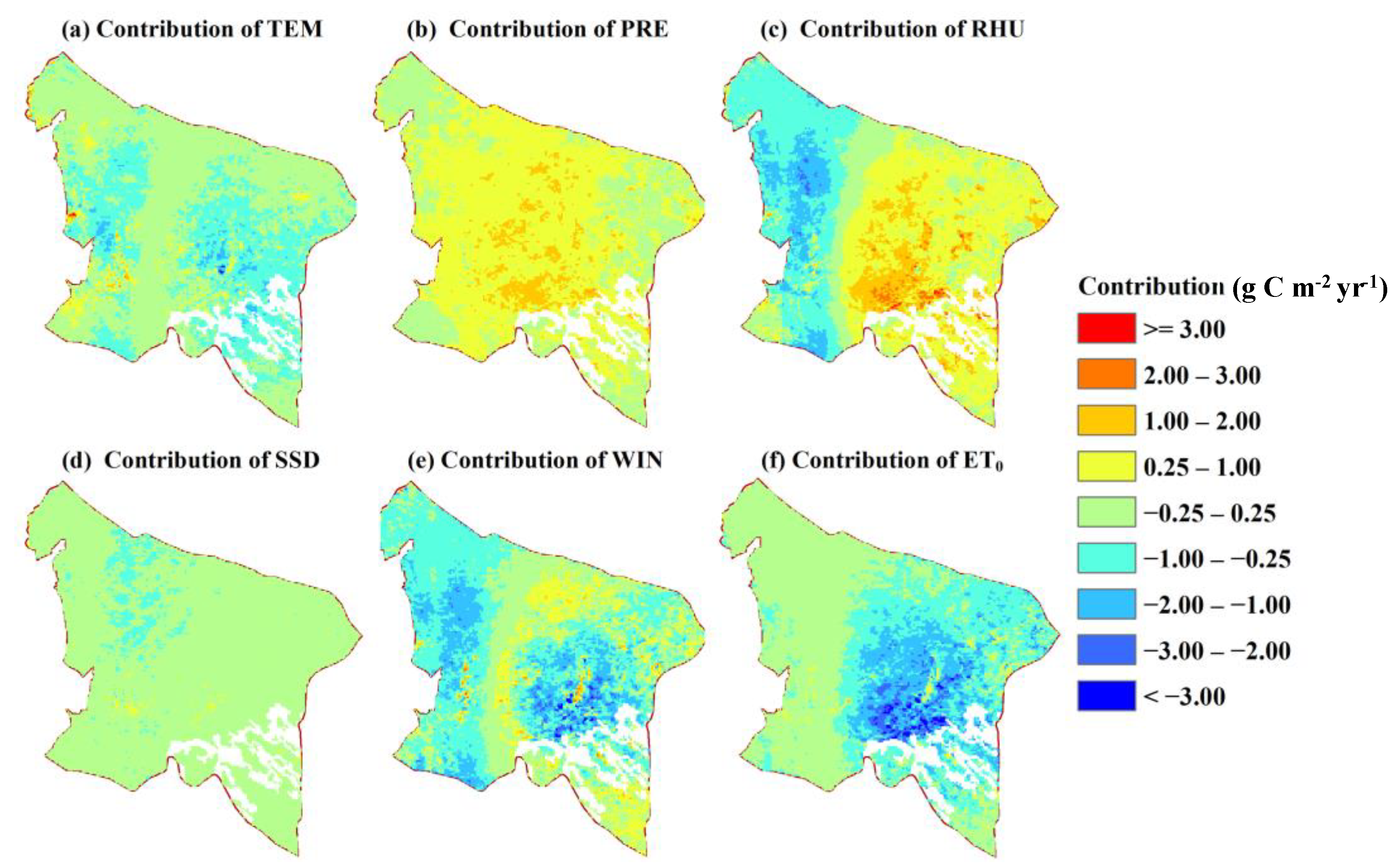
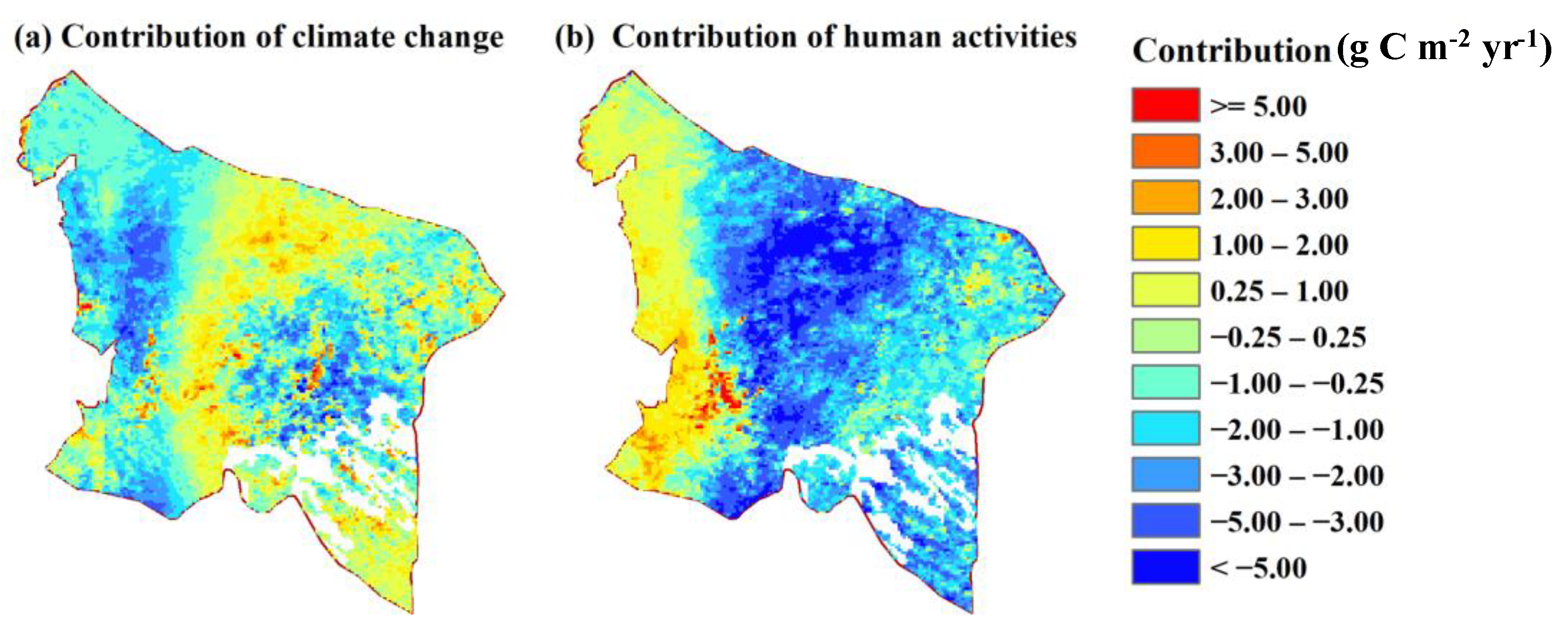


| p | Changing Patterns | |
|---|---|---|
| >0 | <0.05 | Significantly restored |
| >0 | >0.05 | Slightly restored |
| <0 | >0.05 | Slightly degraded |
| <0 | <0.05 | Severely degraded |
| Type | TEM | PRE | RHU | SSD | WIN | ET0 | CC | HA |
|---|---|---|---|---|---|---|---|---|
| WA | −0.003 | 0.479 | 0.268 | −0.022 | 0.126 | −0.255 | 0.593 | −2.733 |
| TS | −0.220 | 0.309 | 0.542 | 0.042 | −0.070 | −0.566 | 0.036 | −1.943 |
| TDS | −0.053 | 0.610 | 0.604 | −0.003 | 0.103 | −0.664 | 0.598 | −3.586 |
| TSD | −0.160 | 0.361 | −0.846 | −0.106 | −0.770 | −0.050 | −1.570 | 0.122 |
| TD | 0.023 | 0.378 | −0.476 | −0.030 | −0.407 | −0.006 | −0.519 | 0.622 |
| LSM | −0.053 | 0.374 | 0.371 | 0.010 | 0.179 | −0.223 | 0.658 | −1.229 |
| OG | −0.094 | 0.300 | 0.405 | 0.020 | 0.137 | −0.315 | 0.453 | −1.646 |
| Scenario | Driving Action | |||
|---|---|---|---|---|
| 1 | >0 | >0 | >0 | , Human-dominated |
| 2 | >0 | <0 | Climate-dominated | |
| 3 | <0 | >0 | Human-dominated | |
| 4 | <0 | <0 | <0 | , Human-dominated |
| 5 | <0 | >0 | Climate-dominated | |
| 6 | >0 | <0 | Human-dominated |
Disclaimer/Publisher’s Note: The statements, opinions and data contained in all publications are solely those of the individual author(s) and contributor(s) and not of MDPI and/or the editor(s). MDPI and/or the editor(s) disclaim responsibility for any injury to people or property resulting from any ideas, methods, instructions or products referred to in the content. |
© 2023 by the authors. Licensee MDPI, Basel, Switzerland. This article is an open access article distributed under the terms and conditions of the Creative Commons Attribution (CC BY) license (https://creativecommons.org/licenses/by/4.0/).
Share and Cite
Liu, H.; Song, X.; Wang, R. Quantitative Impacts of Climate Change and Human Activities on Grassland Productivity in Otog Banner, China from 2001 to 2020. Agronomy 2023, 13, 1140. https://doi.org/10.3390/agronomy13041140
Liu H, Song X, Wang R. Quantitative Impacts of Climate Change and Human Activities on Grassland Productivity in Otog Banner, China from 2001 to 2020. Agronomy. 2023; 13(4):1140. https://doi.org/10.3390/agronomy13041140
Chicago/Turabian StyleLiu, Hui, Xiaoyu Song, and Rongrong Wang. 2023. "Quantitative Impacts of Climate Change and Human Activities on Grassland Productivity in Otog Banner, China from 2001 to 2020" Agronomy 13, no. 4: 1140. https://doi.org/10.3390/agronomy13041140




